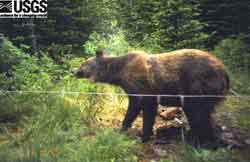
 |
|
|
| Monitoring Grizzly Bear Populations using DNA |  |
PRINCIPAL INVESTIGATORS:
Katherine C. Kendall, USGS Glacier Field Station, Glacier National Park, West Glacier, MT 59936-0128 Email: katherine_kendall@usgs.gov
Lisette Waits, Fish and Wildlife Resources, University of Idaho, Moscow, ID 83844-1136. Email: lwaits@uidaho.edu
Abstract:
No reliable information currently exists on the status of Greater Glacier National Park Area’s grizzly bear or black bear populations. Recent advances in genetic technology allow identification of species, sex, and individuals from DNA extracted from bear hair and scats without handling bears. We will analyze DNA from bear sign collected along survey routes and from a grid of systematically positioned hair snags. The number of individuals and species identified from survey routes will yield minimum counts and a baseline index of population size and will be used to design a non-intrusive population trend monitoring scheme. Bears identified from hair snag collections will be used in a mark-recapture model to estimate the population density and will provide an independent calibration of the population index developed from survey routes. DNA profiles with information on the degree of genetic variation, relatedness of individuals, and sex will be used to address bear conservation issues.
NEWS: Listen to an interview with Kate Kendall on grizzly bear ecology, research, and the future of conservation efforts. Produced by Brian Kahn, Home Ground Radio, Helena, MT. Broadcast by Montana and Yellowstone Public Radio in Montana and Wyoming, April 2001. Interview recorded in Butte, MT March 2001. (get the RealMedia 7 Basic Plugin for FREE). |
 |
U.S. Department of the Interior, U.S. Geological Survey
Northern Rocky Mountain Science Center, BOX 173492, Montana State University,
Bozeman, Montana, 59717-3492
![]() Maintainer: mrblair@usgs.gov
Maintainer: mrblair@usgs.gov
Last Modified: 25 April 2003 11:22
URL:
http://nrmsc.usgs.gov/research/glac_beardna.htm